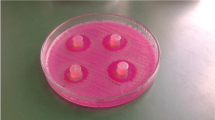Summary
Comparative microbiological investigations of biopsy specimens from the cervix of women with gynaecological infections, and from the cervix secretion of healthy women with normal menstrual cycles, as well as animal experiments were conducted in order to determine the pathogenicity of non-sporeforming anaerobic bacteria in the female genital tract. From the results the following conclusions were drawn: any anaerobic bacterium is considered pathogenic if it is cultured in liquid or solid medium from a non-gravid uterus, the tubes or the exudate in the small pelvis. Bacteria isolated from the cervical canal during puerperium or from the uterus are considered pathogenic if a large number grows on solid culture and if a known pathogenic species predominates. Bacteria isolated from the vagina can be of pathogenic significance if the clinical findings are not normal and if the above-mentioned criteria are considered.
Zusammenfassung
Zur Bestimmung der Pathogenität von nichtsporenbildenden Anaerobiern im weiblichen Genitaltrakt wurden vergleichende mikrobiologische Untersuchungen von Biopsiematerial aus der Cervix uteri von Frauen mit gynäkologischen Infektionen und von Cervixsekret von gesunden Frauen mit normalem Menstruationszyklus vorgenommen sowie Tierexperimente durchgeführt. Aus den Ergebnissen werden folgende Schlüsse abgeleitet: Jeder anaerobe Keim, der in flüssigen und festen Nährmedien aus dem nicht graviden Uterus, den Tuben oder aus Exsudat im kleinen Becken angezüchtet wird, wird als pathogen bewertet. Bakterien, die während des Wochenbettes aus dem Cervixkanal oder aus der Gebärmutterhöhle isoliert werden, gelten als pathogen, wenn sie in großer Menge auf festen Nährböden wachsen und wenn eine bekanntermaßen pathogene Art vorherrscht. Keime, die aus der Vagina isoliert werden, können pathogene Bedeutung haben, wenn es sich nicht um einen klinischen Normalbefund handelt und die oben genannten Kriterien berücksichtigt wurden.
Similar content being viewed by others
Literature
Chow, A. W., Malkasian, K. L., Marshall, J. R., Guze, L. B. The bacteriology of acute pelvic inflammatory disease. Am. J. Obstet. Gynecol. 122 (1975) 877–879.
Decker, H., Herbst, S., Hirsch, H. A. Präoperative Antibiotika-Prophylaxe bei Sectio caesarea. Arch. Gynäkol. 219 (1975) 488–489.
Eschenbach, D. A., Holmes, K. K. Acute pelvic inflammatory disease. Clin. Obstet. Gynecol. 18 (1975) 35–56.
Hirsch, H. A. Vorkommen und Bedeutung anaerober Keime in Gynäkologie und Geburtschilfe. Geburtsh. Frauenheilk. 38 (1978) 170–173.
Lang, N., Werner, H., Boehm, M. Lebensbedrohliche Bacteroides-fragilis-Infektion bei Anwendung eines Dalkon-Shields. Geburtsh. Frauenheilk. 36 (1976) 26–32.
Ledger, W. J., Sweet, R. L., Headington, J. T. Bacteroides species as a cause of severe infections in obstetric and gynecologic patients. Surg. Gynecol. Obstet. 133 (1971) 837–842.
Ohm, M., Scott, J., Galask, R. Cervical-vaginal flora of immunosuppressed renal transplant patients. Am. J. Obstet. Gynecol. 130 (1978) 49–54.
Seeliger, H. P. R., Werner, H. Zur Diagnose und klinischen Bedeutung eines aus einer Pyosalpinx gezüchteten anaeroben Bakterienstammes. Geburtsh. Frauenheilk. 23 (1963) 450–453.
Sweet, R. Anaerobic infections of the female genital tract. Am. J. Obstet. Gynecol. 122 (1975) 891–901.
Katranuschkova, N. Synergism manifestations in anaerobic infections. Acta Med. Bulgar. 1 (1973) 99–104.
Katranuschkova, N.: Anaerobic investigation in the routine practice. Proceedings of 3rd Bulgarian Congress of Microbiology. Bulgarian Academy of Sciences, Sofia 1975, pp. 89–92.
Rights and permissions
About this article
Cite this article
Katranuschkova, N. Pathogenic significance of anaerobic bacteria in the female genital tract. Infection 8 (Suppl 2), S198–S201 (1980). https://doi.org/10.1007/BF01639895
Issue Date:
DOI: https://doi.org/10.1007/BF01639895




